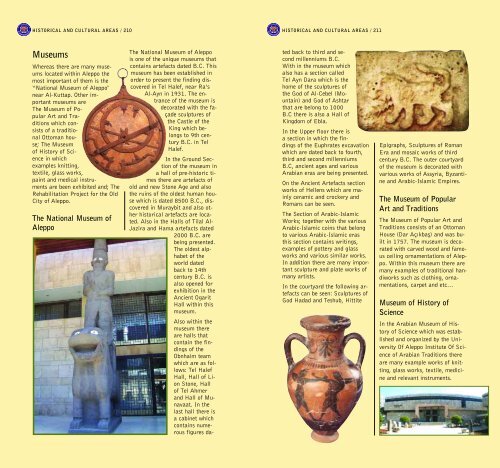You also want an ePaper? Increase the reach of your titles
YUMPU automatically turns print PDFs into web optimized ePapers that Google loves.
HISTORICAL AND CULTURAL AREAS / 210 HISTORICAL AND CULTURAL AREAS / 211<br />
Museums<br />
Whereas there are many museums<br />
located within Aleppo the<br />
most important of them is the<br />
“National Museum of Aleppo"<br />
near Al-Kuttap. Other important<br />
museums are<br />
The Museum of Popular<br />
Art and Traditions<br />
which consists<br />
of a traditional<br />
Ottoman house;<br />
The Museum<br />
of History of Science<br />
in which<br />
examples knitting,<br />
textile, glass works,<br />
paint and medical instruments<br />
are been exhibited and; The<br />
Rehabilitation Project <strong>for</strong> the Old<br />
City of Aleppo.<br />
The National Museum of<br />
Aleppo<br />
The National Museum of Aleppo<br />
is one of the unique museums that<br />
contains artefacts dated B.C. This<br />
museum has been established in<br />
order to present the finding discovered<br />
in Tel Halef, near Ra’s<br />
Al-Ayn in 1931. The entrance<br />
of the museum is<br />
decorated with the façade<br />
sculptures of<br />
the Castle of the<br />
King which belongs<br />
to 9th century<br />
B.C. in Tel<br />
Halef.<br />
In the Ground Section<br />
of the museum in<br />
a hall of pre-historic times<br />
there are artefacts of<br />
old and new Stone Age and also<br />
the ruins of the oldest human house<br />
which is dated 8500 B.C., discovered<br />
in Muraybit and also other<br />
historical artefacts are located.<br />
Also in the Halls of Tilal Al-<br />
Jazira and Hama artefacts dated<br />
2000 B.C. are<br />
being presented.<br />
The oldest alphabet<br />
of the<br />
world dated<br />
back to 14th<br />
century B.C. is<br />
also opened <strong>for</strong><br />
exhibition in the<br />
Ancient Ogarit<br />
Hall within this<br />
museum.<br />
Also within the<br />
museum there<br />
are halls that<br />
contain the findings<br />
of the<br />
Obnhaim team<br />
which are as follows:<br />
Tel Halef<br />
Hall, Hall of Lion<br />
Stone, Hall<br />
of Tel Ahmer<br />
and Hall of Munavaat.<br />
In the<br />
last hall there is<br />
a cabinet which<br />
contains numerous<br />
figures da-<br />
ted back to third and second<br />
millenniums B.C.<br />
With in the museum which<br />
also has a section called<br />
Tel Ayn Dara which is the<br />
home of the sculptures of<br />
the God of Al-Cebel (Mountain)<br />
and God of Ashtar<br />
that are belong to 1000<br />
B.C there is also a Hall of<br />
Kingdom of Ebla.<br />
In the Upper floor there is<br />
a section in which the findings<br />
of the Euphrates excavation<br />
which are dated back to fourth,<br />
third and second millenniums<br />
B.C, ancient ages and various<br />
Arabian eras are being presented.<br />
On the Ancient Artefacts section<br />
works of Hellens which are mainly<br />
ceramic and crockery and<br />
Romans can be seen.<br />
The Section of Arabic-Islamic<br />
Works; together with the various<br />
Arabic-Islamic coins that belong<br />
to various Arabic-Islamic eras<br />
this section contains writings,<br />
examples of pottery and glass<br />
works and various similar works.<br />
In addition there are many important<br />
sculpture and plate works of<br />
many artists.<br />
In the courtyard the following artefacts<br />
can be seen: Sculptures of<br />
God Hadad and Teshub, Hittite<br />
Epigraphs, Sculptures of Roman<br />
Era and mosaic works of third<br />
century B.C. The outer courtyard<br />
of the museum is decorated with<br />
various works of Assyria, Byzantine<br />
and Arabic-Islamic Empires.<br />
The Museum of Popular<br />
Art and Traditions<br />
The Museum of Popular Art and<br />
Traditions consists of an Ottoman<br />
House (Dar Aç›kbafl) and was built<br />
in 1757. The museum is decorated<br />
with carved wood and famous<br />
ceiling ornamentations of Aleppo.<br />
Within this museum there are<br />
many examples of traditional handiworks<br />
such as clothing, ornamentations,<br />
carpet and etc…<br />
Museum of History of<br />
Science<br />
In the Arabian Museum of History<br />
of Science which was established<br />
and organized by the University<br />
Of Aleppo Institute Of Science<br />
of Arabian Traditions there<br />
are many example works of knitting,<br />
glass works, textile, medicine<br />
and relevant instruments.


